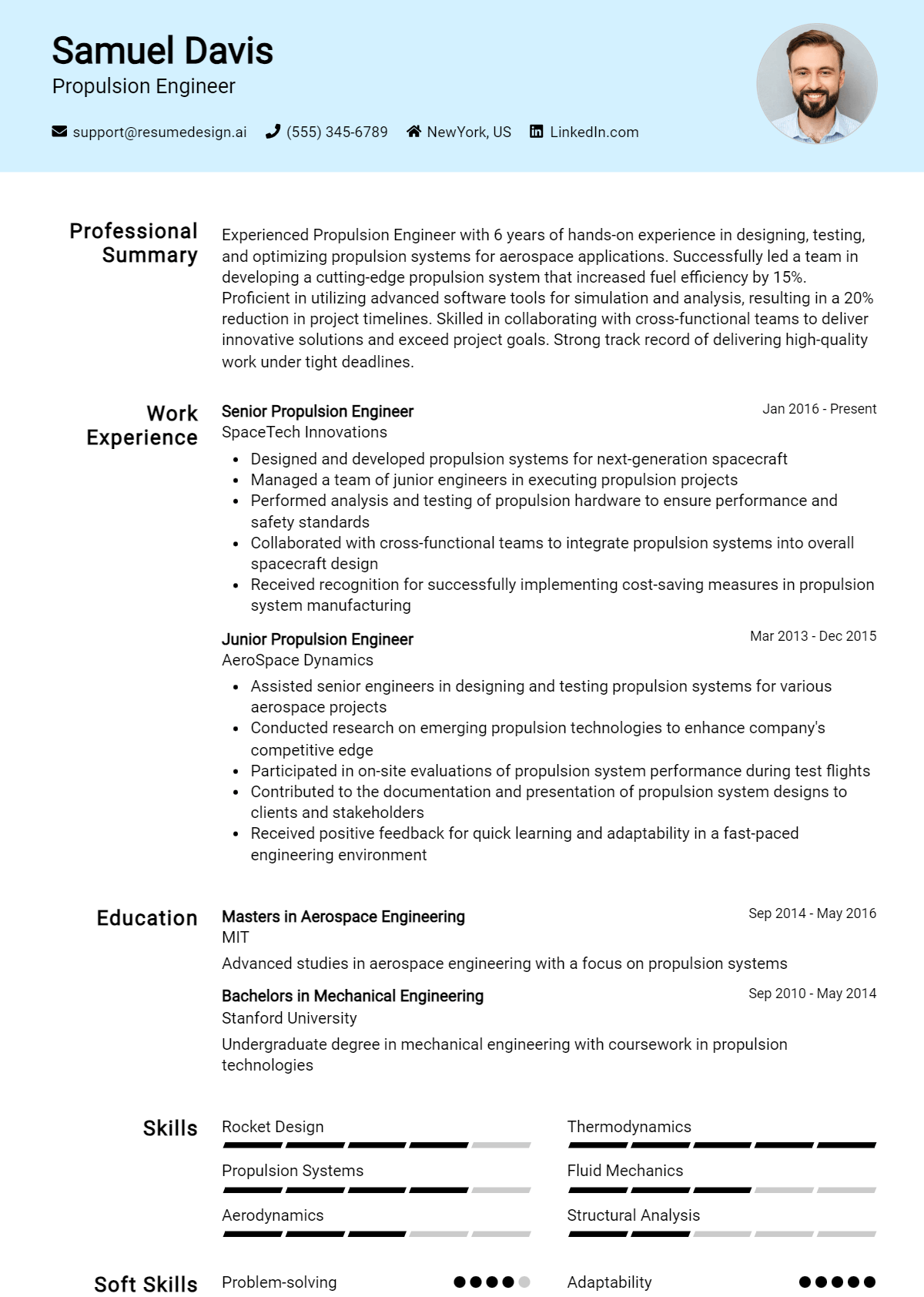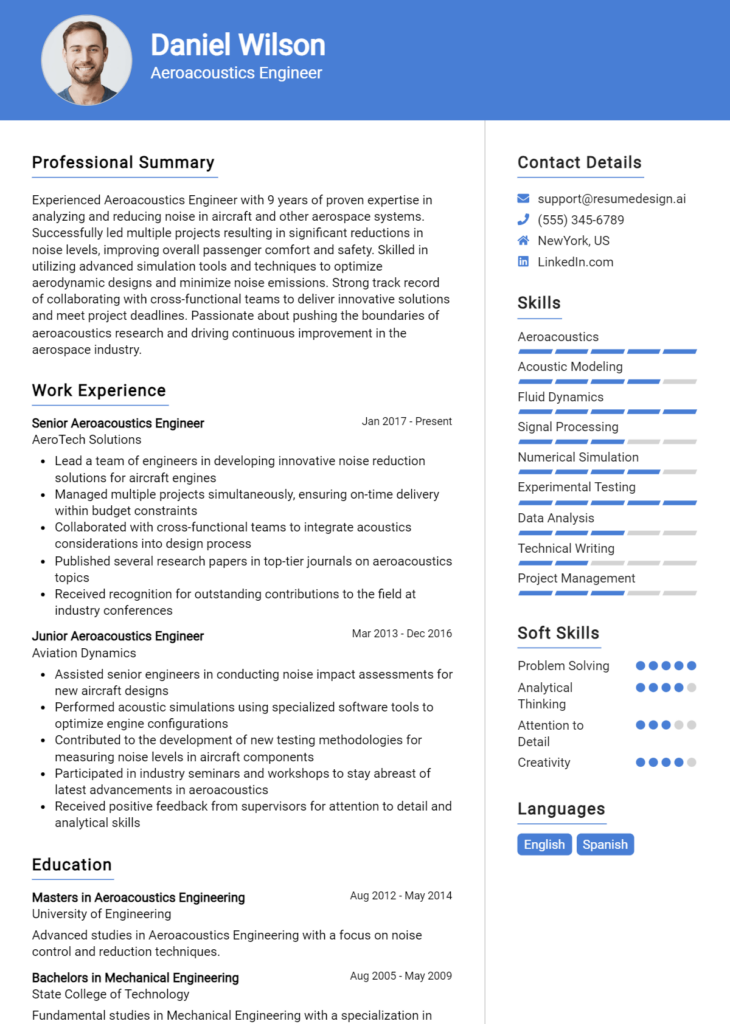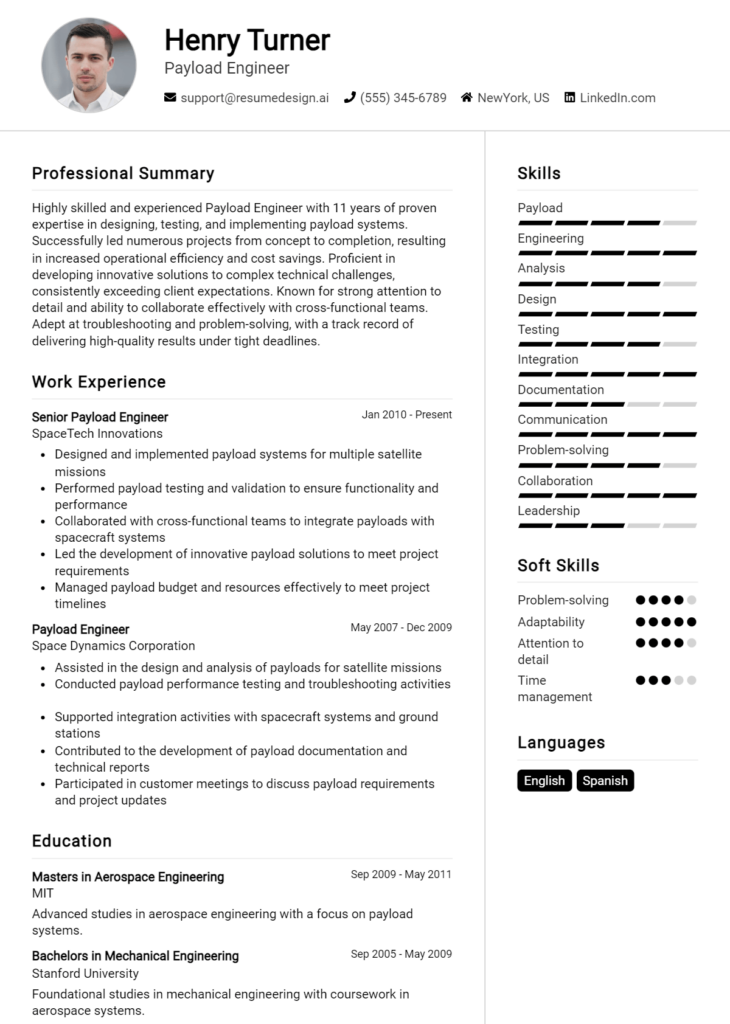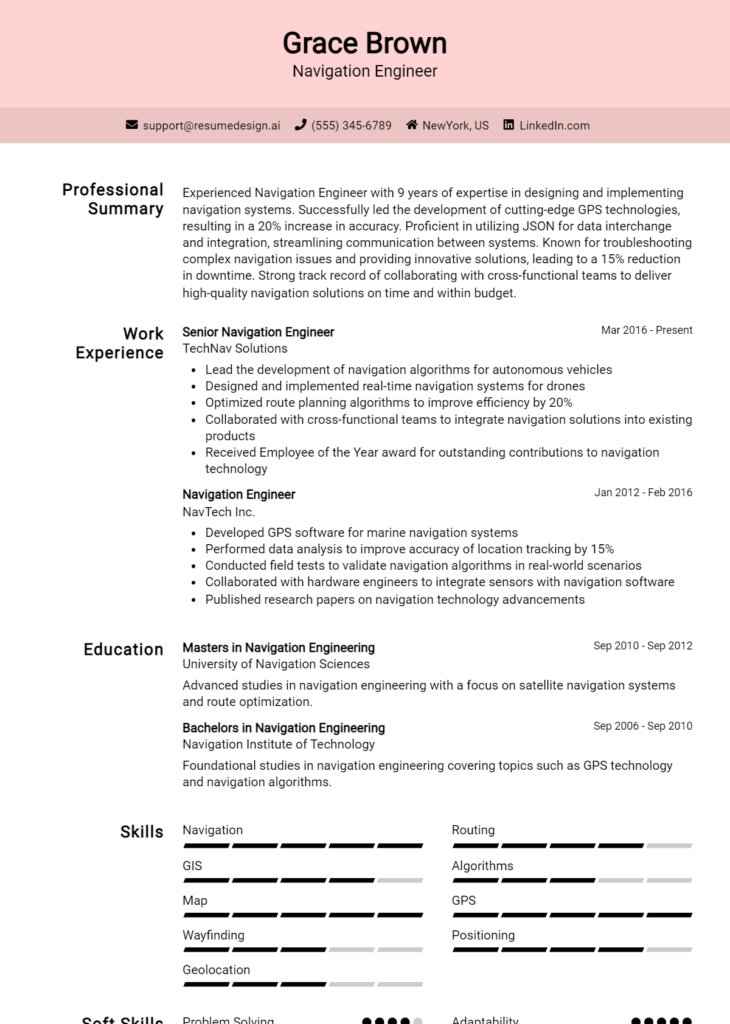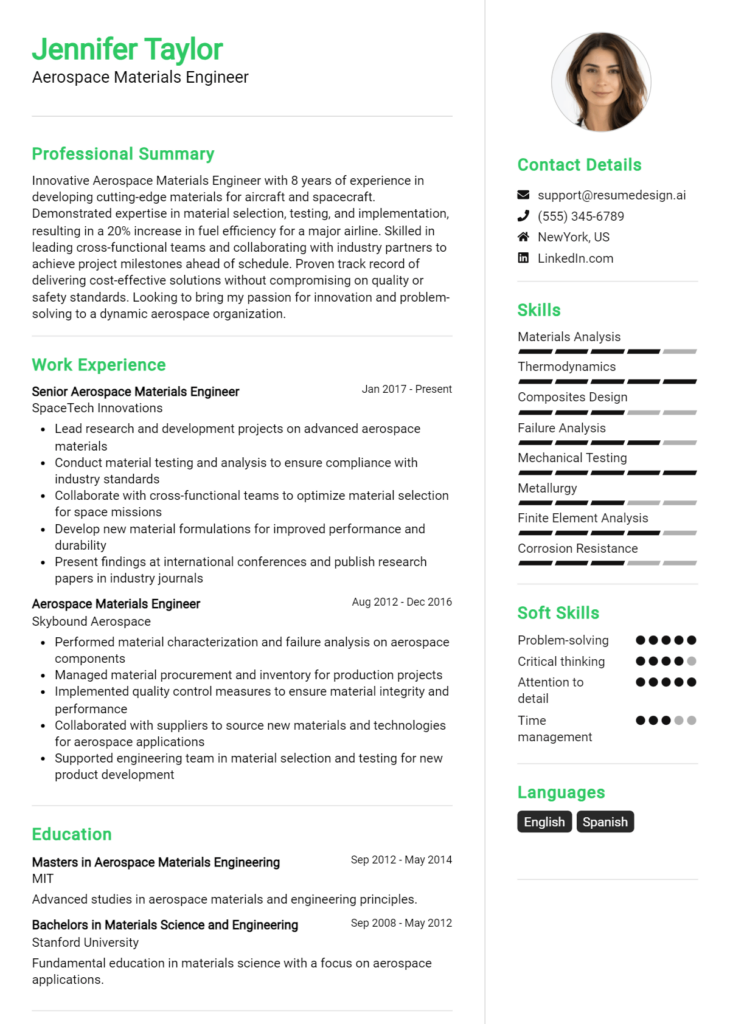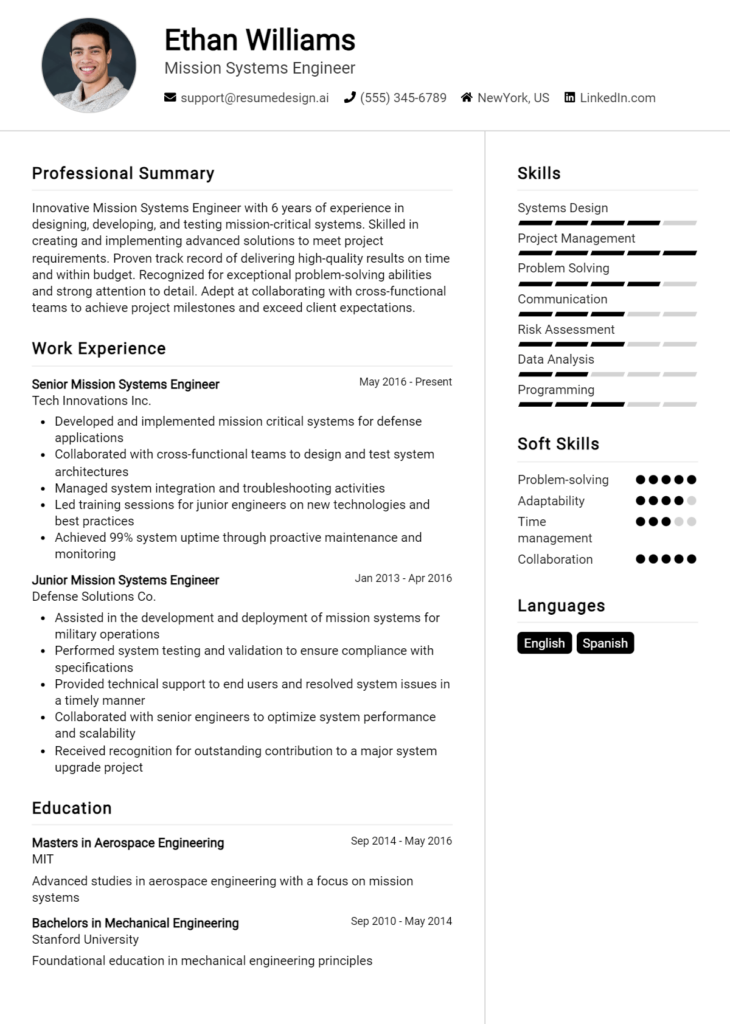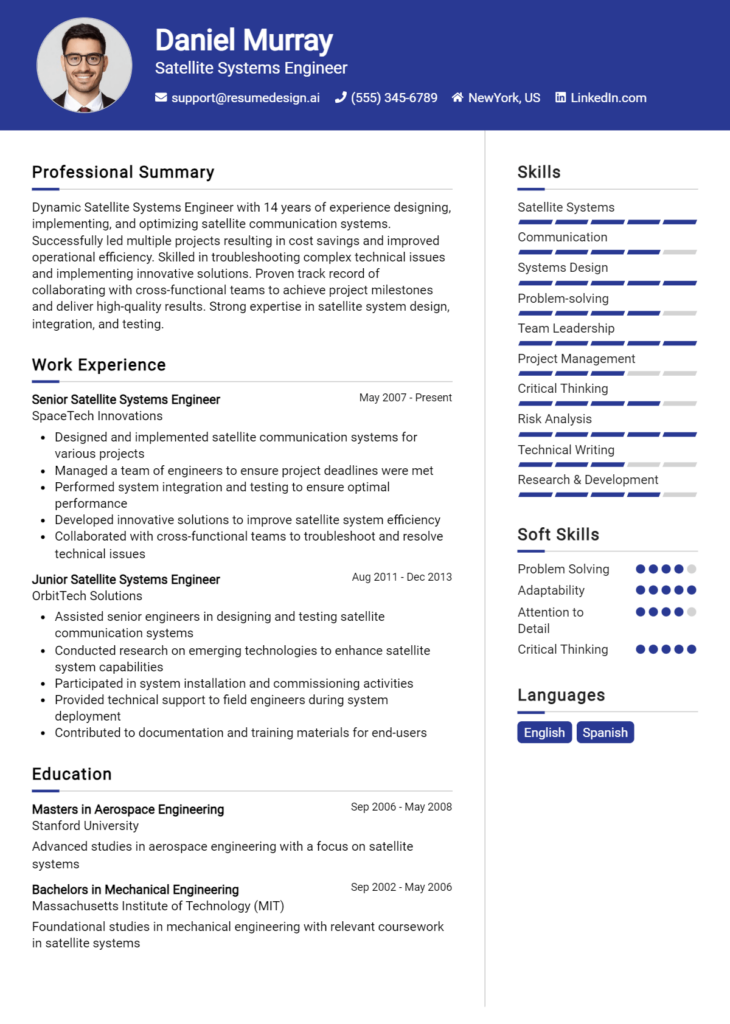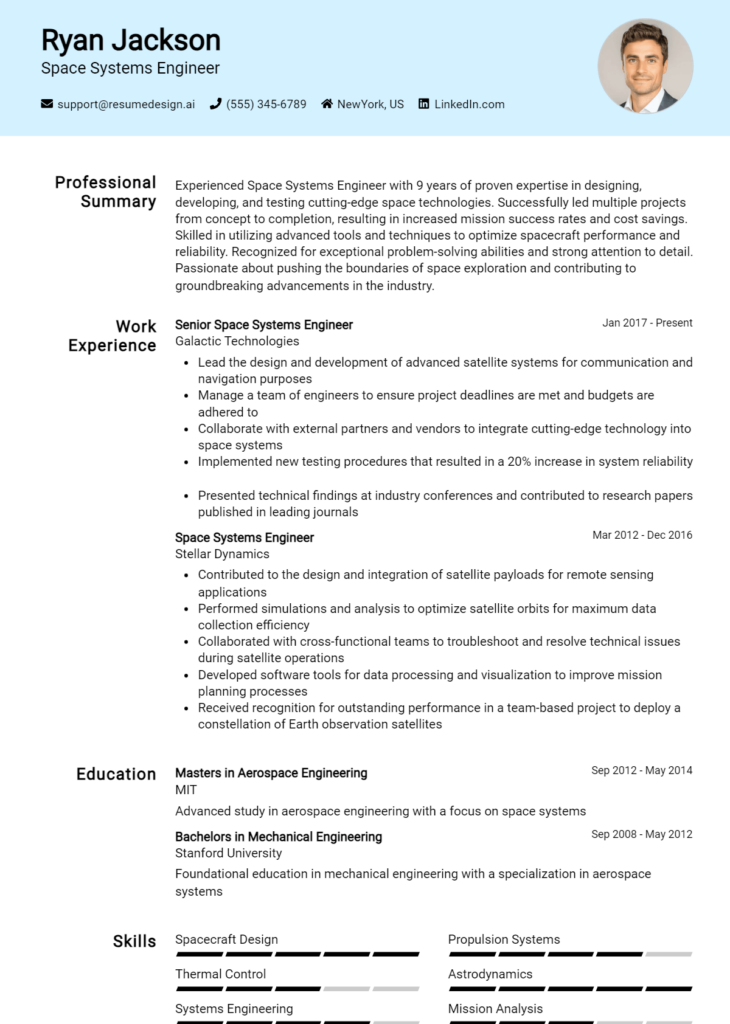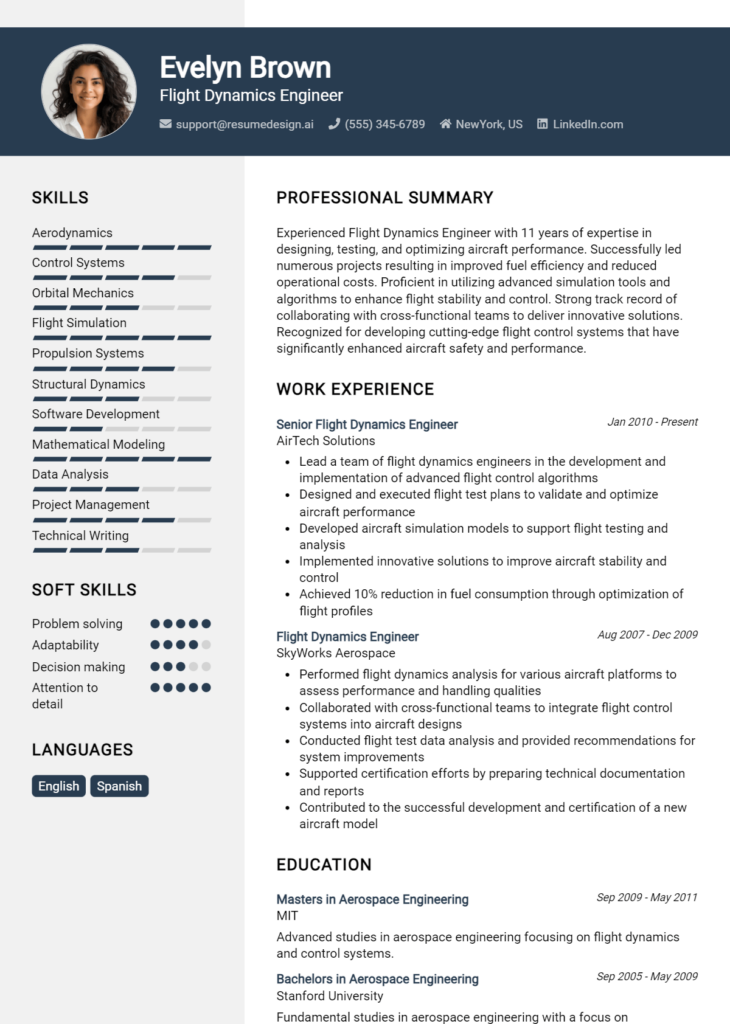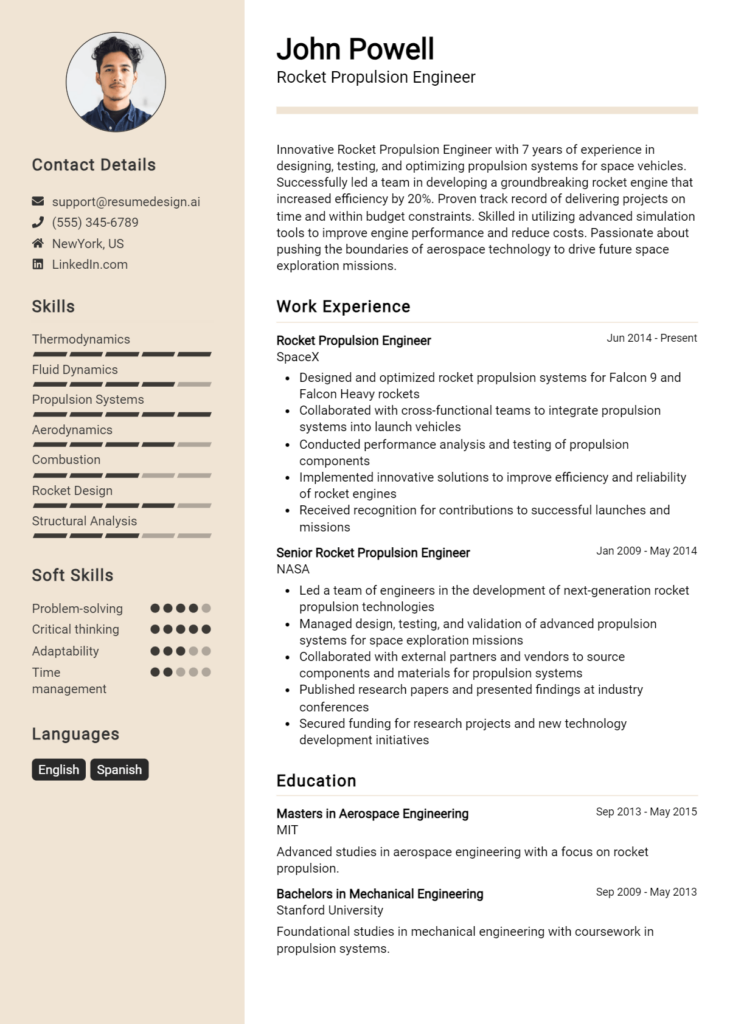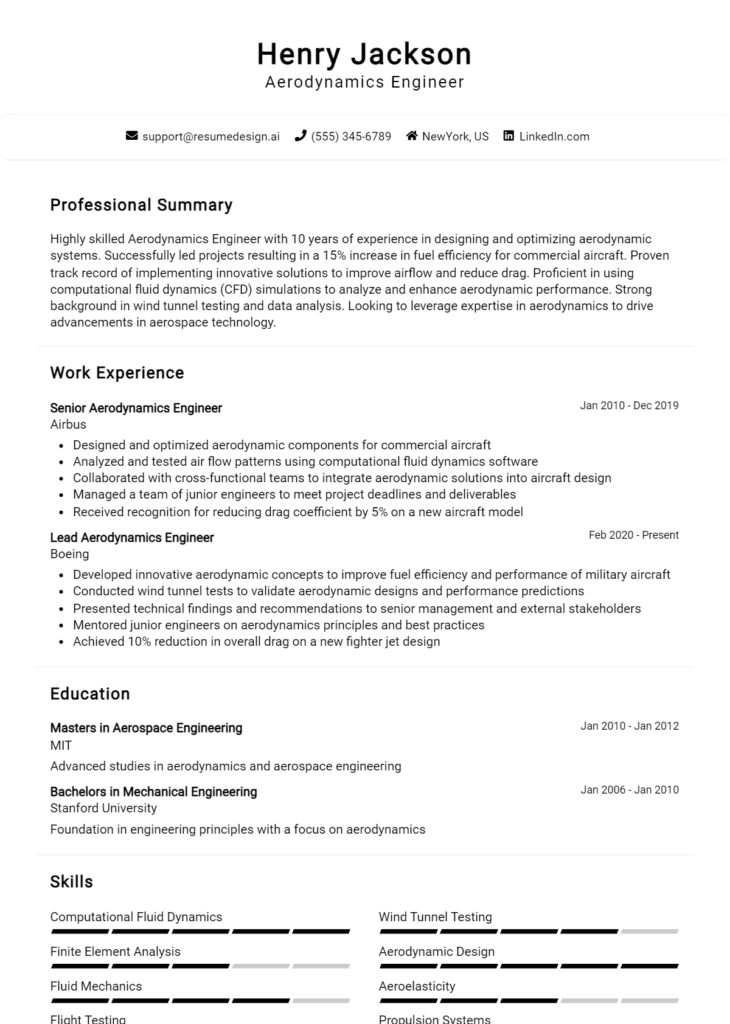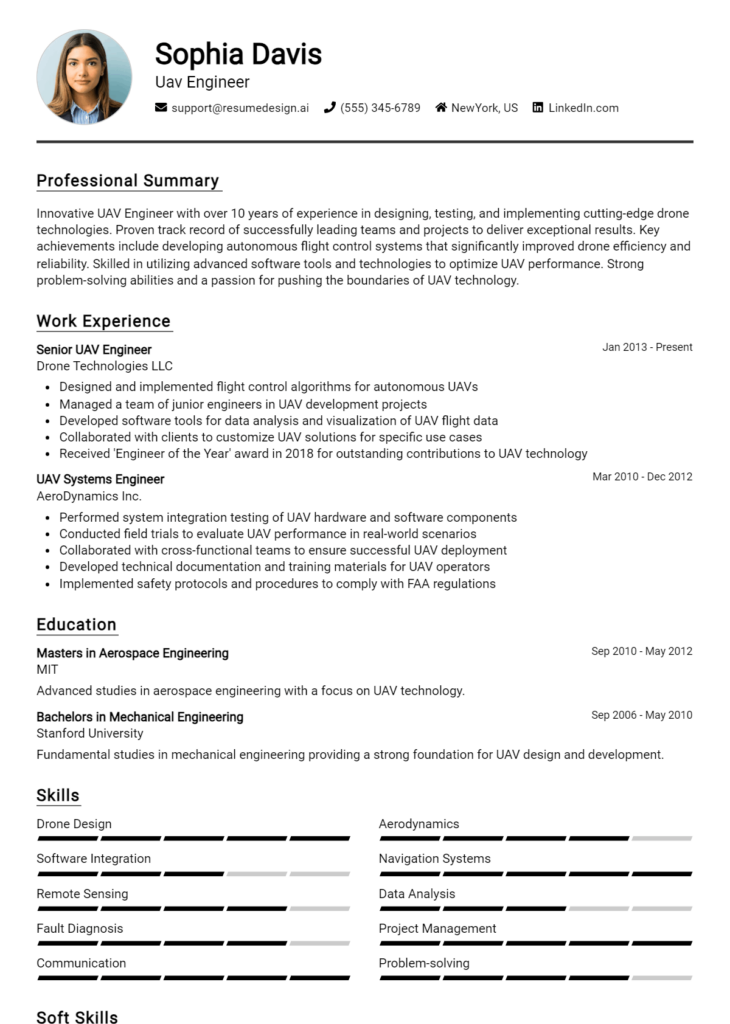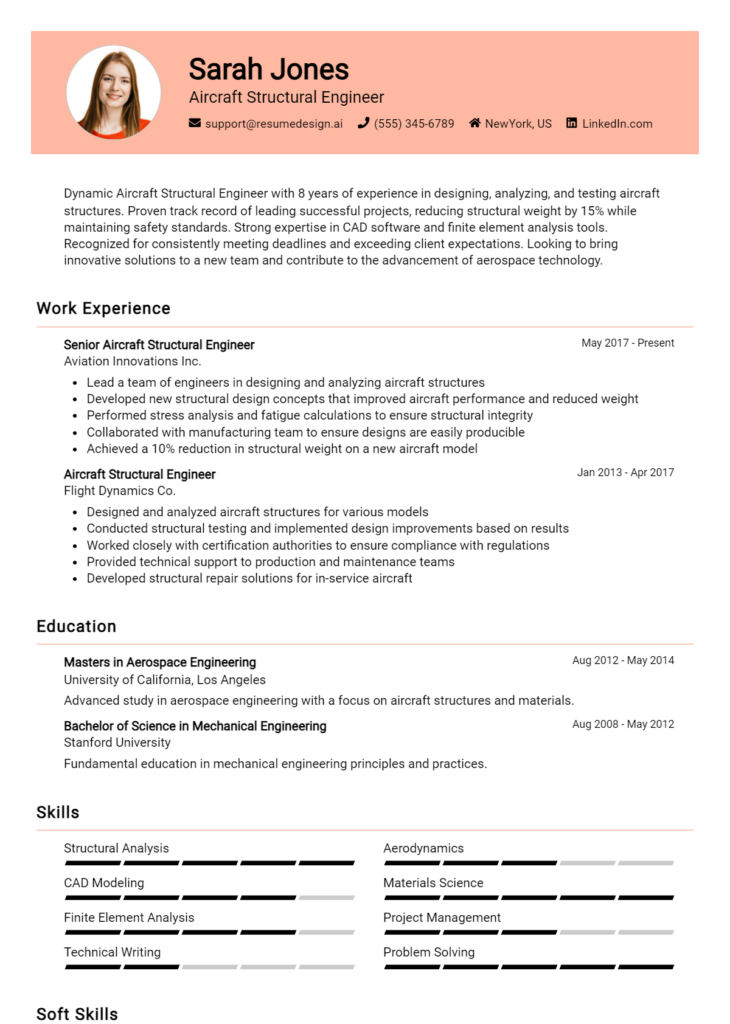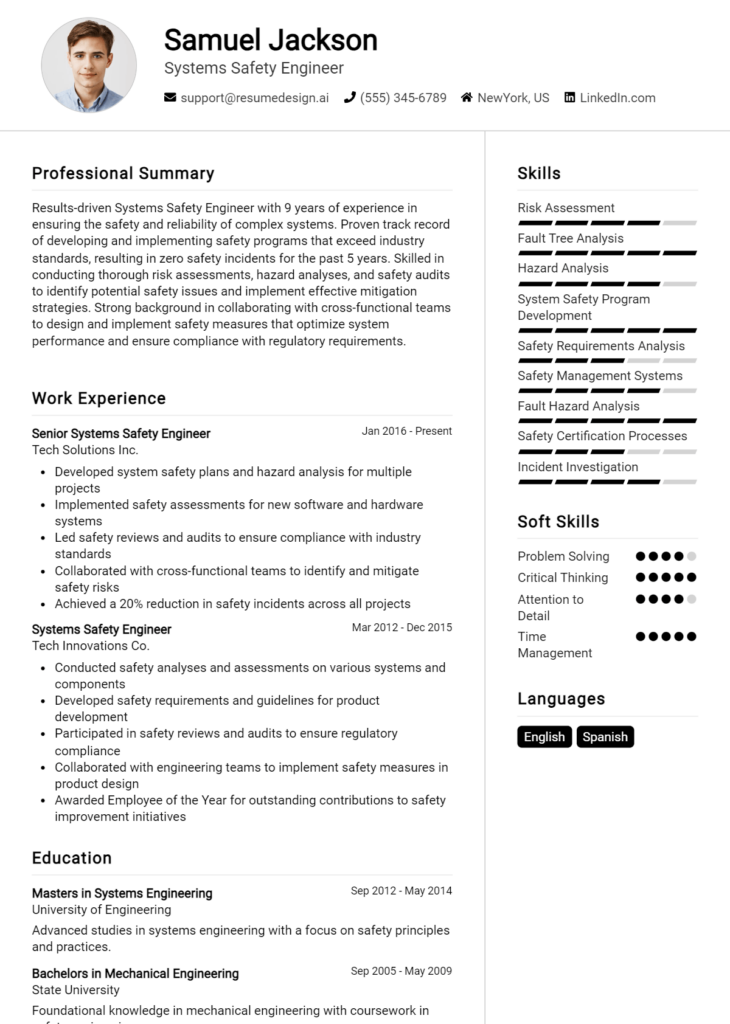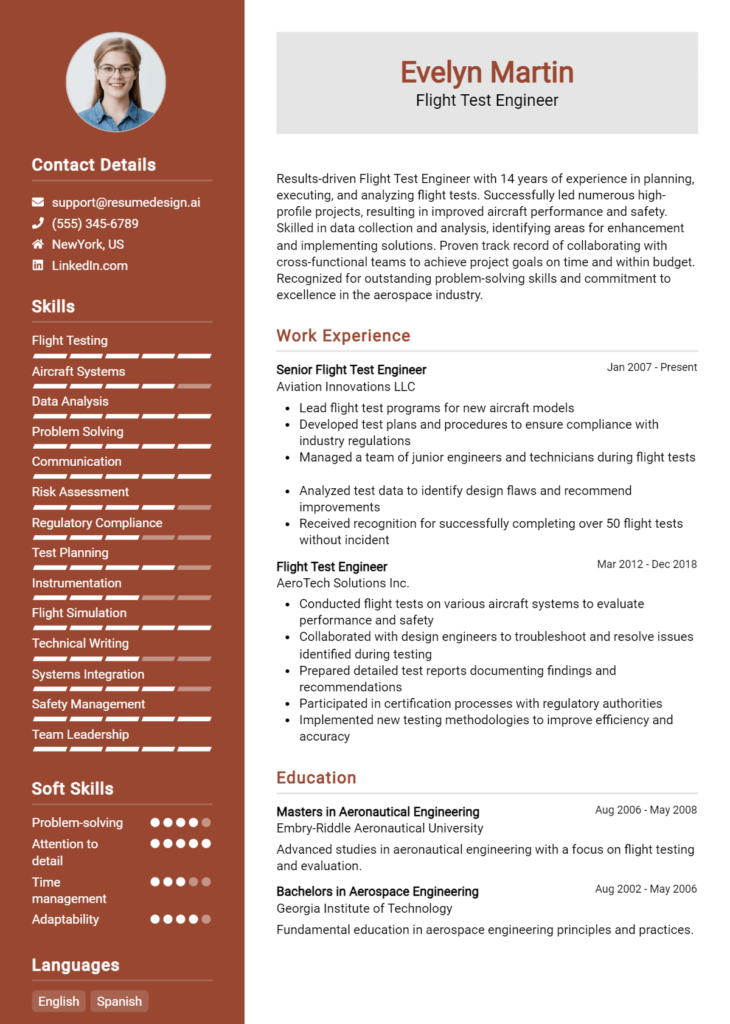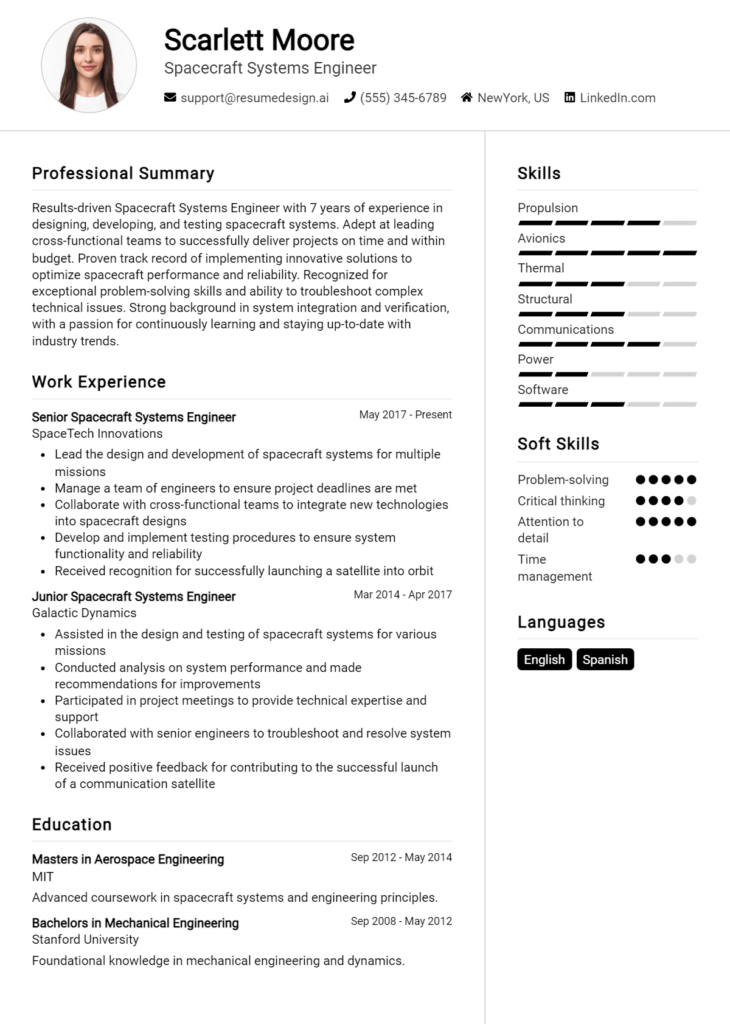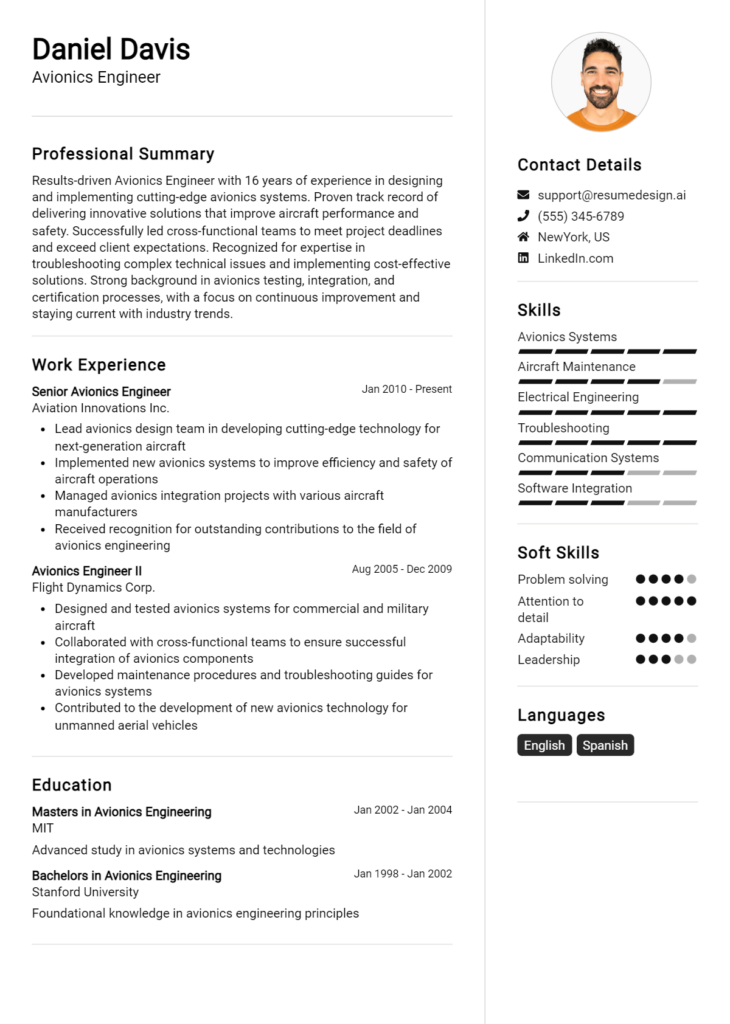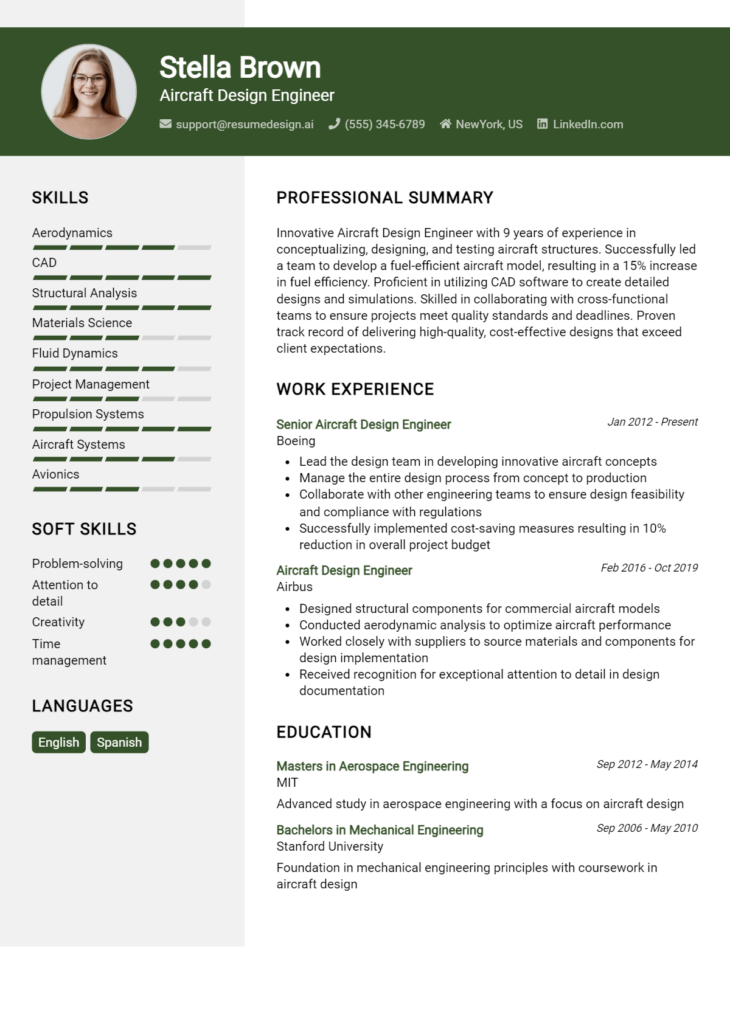Propulsion Engineer Core Responsibilities
A Propulsion Engineer plays a crucial role in the design, development, and testing of propulsion systems for various vehicles, including aircraft and spacecraft. Key responsibilities include analyzing performance data, collaborating with cross-functional teams, and ensuring compliance with safety standards. Essential skills encompass technical expertise in thermodynamics, fluid mechanics, and materials science, along with strong problem-solving and operational capabilities. These skills are vital for achieving organizational goals, and a well-structured resume can effectively highlight these qualifications to potential employers.
Common Responsibilities Listed on Propulsion Engineer Resume
- Design and develop propulsion systems for aerospace applications
- Conduct performance analysis and testing of propulsion components
- Collaborate with multidisciplinary teams to integrate propulsion systems
- Ensure compliance with regulatory standards and safety protocols
- Perform failure analysis and troubleshoot propulsion-related issues
- Utilize computational fluid dynamics (CFD) for system optimization
- Prepare technical documentation and reports for projects
- Participate in design reviews and provide engineering support
- Stay updated on industry advancements and emerging technologies
- Manage project timelines and budgets effectively
High-Level Resume Tips for Propulsion Engineer Professionals
In the competitive field of propulsion engineering, a well-crafted resume serves as a crucial tool for professionals aiming to make a lasting impression on potential employers. As the first point of contact between candidates and hiring managers, a resume must effectively showcase both technical skills and career achievements. Given the specialized nature of propulsion engineering, it's vital that the resume not only highlights qualifications but also aligns closely with the specific requirements of the job. This guide will provide practical and actionable resume tips tailored to propulsion engineer professionals, ensuring that your application stands out in a crowded job market.
Top Resume Tips for Propulsion Engineer Professionals
- Tailor your resume to the job description by incorporating keywords and phrases that align with the specific role you are applying for.
- Highlight relevant experience, focusing on projects and roles that demonstrate your expertise in propulsion systems and technologies.
- Quantify your achievements with specific metrics, such as improvements in efficiency, cost savings, or project completion timelines.
- Include industry-specific skills, such as knowledge of fluid dynamics, thermodynamics, and propulsion system design.
- Showcase your educational background, particularly advanced degrees or certifications relevant to propulsion engineering.
- Utilize a clean, professional format that emphasizes readability and allows key information to stand out.
- Incorporate technical software skills, such as proficiency in MATLAB, ANSYS, or other simulation tools commonly used in propulsion engineering.
- List any relevant professional memberships or affiliations with engineering societies that demonstrate your commitment to the field.
- Demonstrate your problem-solving abilities by including examples of challenges you faced and how you overcame them in your engineering work.
By implementing these tips, propulsion engineers can significantly enhance their resumes, increasing their chances of landing a job in this specialized field. A targeted and effective resume will not only reflect your technical abilities but also convey your passion for propulsion engineering, making you a compelling candidate to potential employers.
Why Resume Headlines & Titles are Important for Propulsion Engineer
In the competitive field of aerospace engineering, particularly for a Propulsion Engineer, a well-crafted resume headline or title is crucial for making a strong first impression. It serves as the candidate's initial pitch to hiring managers, summarizing their key qualifications and drawing attention to their expertise in a concise manner. A compelling headline can encapsulate a candidate's unique skills and experiences in just a few words, making it easier for employers to quickly assess their relevance to the job. Therefore, a good resume headline should be specific, directly related to the position being applied for, and impactful enough to encourage further reading.
Best Practices for Crafting Resume Headlines for Propulsion Engineer
- Keep it concise: Aim for a headline that is brief yet informative, ideally 10 words or less.
- Be role-specific: Tailor the headline to reflect the specific position of Propulsion Engineer.
- Highlight key skills: Include one or two critical skills or areas of expertise relevant to propulsion systems.
- Use action words: Start with strong action verbs to convey proactivity and competence.
- Quantify accomplishments: If possible, include metrics that showcase achievements in previous roles.
- Stay relevant: Ensure that the headline aligns with the job description and requirements of the position.
- Make it impactful: Choose powerful words that evoke professionalism and confidence.
- Avoid clichés: Steer clear of overused phrases that lack specificity or originality.
Example Resume Headlines for Propulsion Engineer
Strong Resume Headlines
Innovative Propulsion Engineer with 10+ Years in Rocket Design and Development
Results-Driven Aerospace Engineer Specializing in Advanced Propulsion Systems
Expert in Propulsion Analysis and Optimization with Proven Project Success
Dynamic Propulsion Engineer with a Track Record of Enhancing Efficiency by 30%
Weak Resume Headlines
Engineer Looking for Work
Propulsion Engineer with Experience
The strong headlines are effective because they provide specific details about the candidate's expertise, experience, and achievements, immediately conveying value to potential employers. They are concise yet rich in information, making them memorable and impactful. In contrast, the weak headlines fail to impress due to their vagueness and lack of specificity; they do not communicate the candidate's distinct qualifications or contributions, making it difficult for hiring managers to see why they would be a good fit for the role.
Writing an Exceptional Propulsion Engineer Resume Summary
A resume summary is a critical component for any Propulsion Engineer seeking to make a lasting impression on hiring managers. This brief introduction serves as a powerful tool to quickly capture attention, highlighting key skills, relevant experience, and notable accomplishments that align with the specific demands of the job role. A well-crafted summary should be concise yet impactful, showcasing the candidate's strengths and tailored to the job description to increase the chances of standing out in a competitive field.
Best Practices for Writing a Propulsion Engineer Resume Summary
- Quantify achievements to demonstrate impact, such as improved efficiency or cost savings.
- Focus on relevant skills specifically mentioned in the job description.
- Tailor the summary to reflect the language and requirements of the job posting.
- Use industry-specific terminology to showcase expertise and familiarity.
- Keep it concise, ideally within 2-4 sentences, to maintain reader engagement.
- Highlight unique contributions or innovations to distinguish from other candidates.
- Include certifications or specialized training relevant to propulsion engineering.
- Showcase teamwork and collaboration experiences, as these are vital in engineering roles.
Example Propulsion Engineer Resume Summaries
Strong Resume Summaries
Dynamic Propulsion Engineer with over 7 years of experience in designing and optimizing propulsion systems for aerospace applications. Successfully led a team that reduced engine emissions by 20% while increasing thrust efficiency by 15%, resulting in a $1 million annual cost savings.
Detail-oriented Propulsion Engineer with a proven track record in developing cutting-edge propulsion technologies. Spearheaded a project that achieved a 30% increase in fuel efficiency for a next-generation jet engine, contributing to a significant reduction in operational costs.
Results-driven Propulsion Engineer with expertise in fluid dynamics and thermodynamics. Developed simulation models that improved testing cycles by 25%, enhancing the reliability of propulsion systems for commercial aircraft.
Weak Resume Summaries
Experienced engineer with a background in propulsion systems. I have worked on various projects and am looking for a new opportunity in aerospace.
Propulsion Engineer with some experience in the field. I am interested in working with a team and contributing to various engineering tasks.
The strong resume summaries stand out because they quantify achievements, clearly define specific skills, and directly relate to the propulsion engineering role. They provide concrete examples of the candidate's impact and expertise, making them memorable to hiring managers. In contrast, the weak summaries lack detail, specific accomplishments, and fail to convey the candidate's unique qualifications, resulting in a generic presentation that doesn't engage potential employers.
Work Experience Section for Propulsion Engineer Resume
The work experience section of a Propulsion Engineer resume is pivotal in demonstrating the candidate's technical expertise, leadership capabilities, and commitment to delivering high-quality results. This section allows potential employers to assess how well the applicant's background aligns with the demands of the role, showcasing their ability to manage engineering teams, execute complex projects, and innovate within the field of propulsion. By quantifying achievements and aligning previous experiences with industry standards, candidates can effectively illustrate their value and suitability for the position.
Best Practices for Propulsion Engineer Work Experience
- Highlight specific technical skills relevant to propulsion systems and technologies.
- Quantify achievements with metrics, such as performance enhancements or cost savings.
- Include leadership roles and examples of team management in projects.
- Demonstrate collaboration with multidisciplinary teams, emphasizing communication skills.
- Align experience descriptions with industry standards and terminology.
- Focus on results-driven statements that reflect problem-solving abilities.
- Use action verbs to convey a proactive approach and initiative.
- Tailor the work experience section to the specific job description applied for.
Example Work Experiences for Propulsion Engineer
Strong Experiences
- Led a team of 10 engineers in the design and testing of a next-generation rocket engine, resulting in a 20% increase in thrust-to-weight ratio and a 15% reduction in manufacturing costs.
- Developed advanced simulation models for propulsion systems, decreasing validation time by 30%, which accelerated project timelines and improved reliability metrics.
- Collaborated with cross-functional teams to integrate propulsion systems into spacecraft, achieving successful launches for three consecutive missions with zero failures.
Weak Experiences
- Worked on engine projects and assisted other engineers.
- Participated in meetings about propulsion systems without clear contributions.
- Helped with testing and documentation of propulsion technologies.
The examples provided illustrate a clear distinction between strong and weak experiences. Strong experiences are characterized by specific, quantifiable outcomes, clear leadership roles, and collaborative efforts that demonstrate the candidate's significant impact on projects. In contrast, weak experiences lack detail, specificity, and measurable achievements, making it difficult for employers to assess the candidate's true capabilities and contributions in the field of propulsion engineering.
Education and Certifications Section for Propulsion Engineer Resume
The Education and Certifications section of a Propulsion Engineer resume is critical as it showcases the candidate's academic foundation and commitment to professional development in a highly specialized field. This section not only highlights relevant degrees and coursework but also emphasizes industry-recognized certifications and ongoing education that demonstrate the candidate's dedication to staying current with technological advancements and best practices. By providing detailed information about relevant educational experiences and certifications, candidates can significantly enhance their credibility and align their qualifications with the specific demands of the propulsion engineering role.
Best Practices for Propulsion Engineer Education and Certifications
- Include degrees in aerospace engineering, mechanical engineering, or related fields to demonstrate relevant educational background.
- List industry-recognized certifications such as Certified Aerospace Engineer (CAE) or relevant professional licenses.
- Highlight relevant coursework that pertains to propulsion systems, fluid dynamics, or thermodynamics.
- Showcase specialized training programs or workshops that further enhance skills in propulsion technologies.
- Keep the information concise and focused on qualifications that directly relate to the job role.
- Order entries by relevance and recency, placing the most pertinent information at the top.
- Consider including GPA or honors if they are particularly strong and relevant.
- Regularly update this section to reflect new certifications or educational achievements.
Example Education and Certifications for Propulsion Engineer
Strong Examples
- B.S. in Aerospace Engineering, Massachusetts Institute of Technology, 2020
- M.S. in Propulsion Systems, California Institute of Technology, 2022
- Certified Aerospace Engineer (CAE), National Council of Examiners for Engineering and Surveying, 2023
- Coursework: Advanced Fluid Dynamics, Thermodynamics of Propulsion Systems, and Rocket Propulsion Design.
Weak Examples
- B.A. in History, University of California, 2015
- Certification in Basic Computer Skills, 2020
- Coursework: Introduction to Psychology and General Biology.
- High School Diploma, 2011
The strong examples provided showcase relevant educational qualifications and certifications directly applicable to the propulsion engineering field, demonstrating the candidate's preparedness and expertise. In contrast, the weak examples reflect a lack of pertinent education and credentials, which may not align with the expectations of hiring managers seeking qualified propulsion engineers. Highlighting relevant degrees, specialized certifications, and focused coursework is essential for establishing a credible and competitive profile in this technical domain.
Top Skills & Keywords for Propulsion Engineer Resume
As a Propulsion Engineer, the combination of technical expertise and interpersonal skills is crucial for success in the field. A strong resume that highlights relevant skills can set a candidate apart in a competitive job market. Employers seek individuals who not only possess the necessary hard skills to design, test, and improve propulsion systems but also demonstrate soft skills that facilitate teamwork, communication, and problem-solving. A well-crafted resume that showcases these skills can effectively convey a candidate's qualifications and potential contributions to prospective employers. For those looking to enhance their resumes, understanding the importance of both hard and soft skills is vital.
Top Hard & Soft Skills for Propulsion Engineer
Soft Skills
- Problem-solving
- Team collaboration
- Effective communication
- Attention to detail
- Adaptability
- Critical thinking
- Creativity
- Time management
- Leadership
- Conflict resolution
- Analytical thinking
- Decision-making
- Interpersonal skills
- Project management
- Initiative
- Resilience
Hard Skills
- Fluid dynamics
- Thermodynamics
- Structural analysis
- Computational fluid dynamics (CFD)
- Propulsion system design
- System integration
- Materials science
- Engine testing and evaluation
- Simulation software proficiency (e.g., ANSYS, MATLAB)
- Aerospace regulations and compliance
- Control systems engineering
- Data analysis and visualization
- Prototyping and testing methodologies
- CAD software proficiency (e.g., SolidWorks, CATIA)
- Troubleshooting and diagnostics
- Performance analysis and optimization
For more details on enhancing your skills and presenting your work experience effectively, consider exploring additional resources.
Stand Out with a Winning Propulsion Engineer Cover Letter
Dear Hiring Manager,
I am writing to express my strong interest in the Propulsion Engineer position at [Company Name] as advertised on [Job Board/Company Website]. With a Bachelor’s degree in Aerospace Engineering and over [X years] of hands-on experience in propulsion systems design and analysis, I am excited about the opportunity to contribute to your team. My background in both theoretical and practical applications of propulsion technologies has equipped me with the skills necessary to tackle complex engineering challenges and drive innovation in propulsion systems.
During my previous role at [Previous Company Name], I successfully led a team in the development of a new hybrid propulsion system that improved fuel efficiency by 15%. This project involved extensive research and collaboration with cross-functional teams, allowing me to hone my project management and communication skills. I am proficient in using simulation software such as ANSYS and MATLAB, which has enabled me to conduct thorough performance analyses and optimize designs for various propulsion systems. My passion for aerospace technology, combined with my technical expertise, drives my commitment to delivering high-quality solutions.
I am particularly drawn to [Company Name] because of your commitment to advancing sustainable propulsion technologies. I admire your recent projects, such as [specific project or initiative], and I am eager to bring my experience in developing eco-friendly propulsion systems to your team. I am confident that my innovative approach and dedication to excellence would make me a valuable asset in achieving [Company Name]'s goals.
Thank you for considering my application. I look forward to the opportunity to discuss how my background, skills, and enthusiasms align with the needs of your team. I am excited about the possibility of contributing to [Company Name] and am eager to bring my expertise to your esteemed organization.
Sincerely,
[Your Name]
[Your Contact Information]
Common Mistakes to Avoid in a Propulsion Engineer Resume
When crafting a resume for a propulsion engineer position, it's essential to present your skills and experiences effectively. Unfortunately, many candidates fall into the trap of common mistakes that can undermine their qualifications. Avoiding these pitfalls can significantly enhance your chances of making a positive impression on hiring managers and securing that crucial interview. Here are some frequent mistakes to be aware of:
Generic Objective Statement: Using a vague objective that doesn't specify your interest in propulsion engineering can make your resume blend in with countless others. Tailor your objective to reflect your passion and goals within the field.
Overloading Technical Jargon: While technical language is important in engineering, overloading your resume with jargon can confuse readers. Ensure that your language is accessible and highlights your skills without overwhelming the reader.
Ignoring Relevant Experience: Sometimes, candidates focus solely on formal jobs and neglect relevant projects, internships, or coursework. Include all pertinent experiences that demonstrate your skills and knowledge in propulsion systems.
Neglecting Soft Skills: Propulsion engineering often requires teamwork, communication, and problem-solving skills. Failing to emphasize these soft skills can give a one-dimensional view of your capabilities.
Poor Formatting: A cluttered or unprofessional format can detract from your qualifications. Use clear headings, bullet points, and consistent fonts to enhance readability and make a lasting impression.
Lack of Quantifiable Achievements: Instead of merely listing responsibilities, highlight your accomplishments using numbers and specific examples. For instance, mention how you improved efficiency by a certain percentage or completed a project ahead of schedule.
Typos and Grammatical Errors: Mistakes in spelling or grammar can signal a lack of attention to detail, which is critical in engineering roles. Always proofread your resume or have someone else review it before submission.
Not Customizing for Each Application: Sending out a generic resume for multiple job applications can diminish your chances of standing out. Tailor your resume to each position by emphasizing the most relevant skills and experiences related to the job description.
Conclusion
As a Propulsion Engineer, your role is pivotal in the design, development, and testing of propulsion systems for various applications, including aerospace and automotive industries. Throughout this article, we explored the essential skills and qualifications required for this career, such as a strong foundation in thermodynamics, fluid mechanics, and materials science. We also highlighted the importance of hands-on experience through internships and projects, as well as the ability to work collaboratively within multidisciplinary teams.
Moreover, we discussed key responsibilities, including conducting simulations, analyzing performance data, and ensuring compliance with safety regulations. Staying updated with the latest technologies and methodologies is crucial for success in this field, as is the ability to communicate technical concepts effectively to both technical and non-technical stakeholders.
Now that you have a better understanding of what it takes to excel as a Propulsion Engineer, it's time to take action. Review your resume to ensure it reflects your skills, experiences, and achievements accurately. To assist you in this process, utilize the variety of resources available:
- Explore resume templates to create a visually appealing format.
- Use the resume builder for a straightforward way to craft a professional document.
- Check out resume examples for inspiration on how to present your qualifications effectively.
- Don't forget to craft a compelling cover letter with the help of cover letter templates.
By leveraging these tools, you can enhance your resume and stand out in your job search as a Propulsion Engineer. Take the first step towards your career advancement today!

